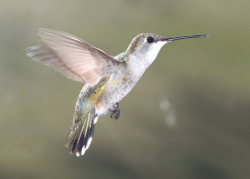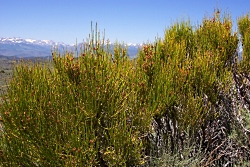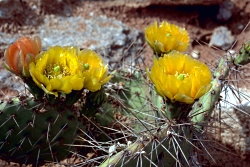
and Drink Nectar From Flowers
Black-chinned Hummingbird
Archilochus alexandri
Courtesy US FWS, Alan Schmierer, Photographer
When we think about landscaping for the birds we might think of the National Wildlife Federation guidelines to include food, water, shelter and places to raise young, but chances are the foods we think of first are berries, nuts, and seeds, when in fact the single most important food to ensure the survival of songbirds are the insects hosted by native plants. The Bridgerland Audubon Society website includes a wealth of resources on many aspects of Bird_Friendly Living, not least of which native plants for Utah gardens.
Douglas Tallamy’s website “Bringing Nature Home” states that most songbirds need insect protein for their young, and the top plant species that host the caterpillars birds need are oak, cherry and willow. Just one of many plants to share with birds is the Chokecherry, preferably with green leaves, as the red-leafed cultivars are not attractive to insects. Chokecherry fruits are great for people and birds, and the leaves will host insects for baby birds. Remember, those little hummingbirds aren’t just sipping nectar and pollinating flowers, they’re eating aphids and mosquitoes, serving an important pest management role in your garden!
I will now read the Mayor’s Proclamation to Grow Native for Birds, a timeless summary of the reasons to err toward native plants:
Proclamation To Grow Native For Birds:
Whereas, growing native plant communities in our residential, municipal and commercial landscapes promotes and enhances our sense of place; and Whereas, increased awareness and use of native plants is fundamental to water conservation, water quality, habitat preservation and successful gardening; and
Whereas, gardens and landscapes composed of Utah’s native plants require little or no fertilizers, soil amendments, or pesticides; and
Whereas, using firewise plants native in our landscape is often the safest option; and
Whereas, landscaping choices have meaningful effects on the native insects that bird populations need to survive; and
Whereas, a diversity of birds is indicative of a healthy ecosystem, including biological control of pests, carrion regulation, seed dispersal, and nutrient cycling; and
Whereas, birdwatching can be a fun, relaxing, multigenerational, educational family wellness activity;
Now, Therefore, we do hereby declare this Proclamation to Grow Native for Birds and encourage everyone to actively foster and support the use of Utah native plants in their gardens and landscapes.
I’m Hilary Shughart with the Bridgerland Audubon Society, and I’m Wild About Utah
Credits:
Photo: Courtesy US FWS, Alan Schmierer, Photographer, https://images.fws.gov/
Featured Audio: Courtesy & Copyright © Kevin Colver, https://wildstore.wildsanctuary.com/collections/special-collections/kevin-colver
Text: Hilary Shughart, President, https://bridgerlandaudubon.org/
Additional Reading: Hilary Shughart and Lyle Bingham, https://bridgerlandaudubon.org/
Additional Reading
Grow Native For Birds Project, Bridgerland Audubon Society, https://bridgerlandaudubon.org/our-projects/grow-native-for-birds/
Logan, UT Mayor Holly Daines, Proclamation to Grow Native for Birds,
Facebook Live, https://www.facebook.com/watch/?v=2627914670831507
Text: https://bridgerlandaudubon.org/wp-content/uploads/2020/04/Proclamation.pdf
Grow Native For Birds, Bridgerland Audubon Society, https://bridgerlandaudubon.org/our-projects/grow-native-for-birds/
Liberatore, Andrea, Grow Native!, Wild About Utah, June 9, 2011, https://wildaboututah.org/grow-native/
Hellstern, Ron, Attracting Birds and Butterflies to Your Yard, Wild About Utah, May 28, 2018, https://wildaboututah.org/attracting-birds-and-butterflies-to-your-yard/
Hellstern, Ron, Build a Certified Wildlife Habitat at Home, Wild About Utah, Jul 17, 2017, https://wildaboututah.org/build-community-wildlife-habitats/
National Audubon Native Plant Finder, Coleman and Susan Burke Center for Native Plants, Audubon.org, https://www.audubon.org/plantsforbirds
Native Plants For Birds, National Audubon Society
Nov 20, 2017
Cane, James, Gardening for Native Bees in Utah and Beyond, (includes a flowering calendar for cultivated bee plants), https://extension.usu.edu/files/publications/factsheet/plants-pollinators09.pdf
RESOURCES: Water-Wise and Native Plants, Center for Water Efficient Landscaping, Utah State University Extension, https://cwel.usu.edu/plants
Kuhns, MIchael, Are Native Trees Always the Best Choices?, Forestry, Utah State University Extension, https://forestry.usu.edu/trees-cities-towns/tree-selection/native-trees
Creating Landscapes for Wildlife… A Guide for Backyards in Utah, Written by Sue Nordstrom and Illustrated by Kathlyn Collins Department of Landscape Architecture and Environmental Planning, Utah State University with Margy Halpin, Utah Division of Wildlife Resources; Second Printing 2001,
Updated for the Utah Division of Wildlife Resources, by Frank Howe, DWR Avian coordinator; Ben Franklin, DWR–Utah Natural Heritage Program botanist; Randy Brudnicki, DWR publications editor; and landscape planning illustrations by Stephanie Duer.,
Published by:
State of Utah Natural Resources, Division of Wildlife Resources,
Utah State University Cooperative Extension Service and
Utah State University Department of Landscape Architecture and Environmental Planning;
1991 updated 2001 https://wildlife.utah.gov/pdf/landscapingforwildlife.pdf
Handbook on Riparian Restoration, Utah Division of Wildlife Resources, Utah Department of Natural Resources, State of Utah, https://wildlife.utah.gov/pdf/riparian.pdf
Kirchner, Jane, Meet the Squad of Mosquito-Eating Species, National Wildlife Federation, August 24, 2020, https://blog.nwf.org/2020/08/meet-the-squad-of-mosquito-eating-species/


